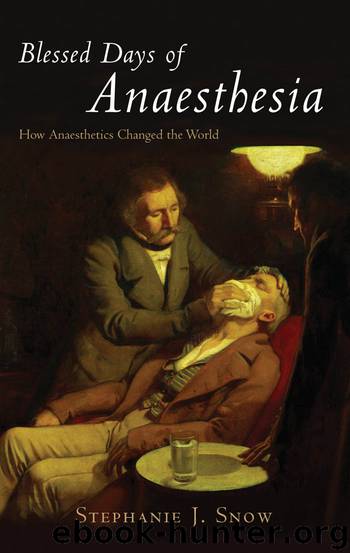Blessed Days of Anaesthesia by Snow Stephanie J.;

Author:Snow, Stephanie J.;
Language: eng
Format: epub
Publisher: Oxford University Press
Published: 2012-12-04T05:00:00+00:00
Figure 9 Florence Nightingale at Scutari.
Young military surgeons like Edward Wrench, trained at St Thomas’s Hospital in the early 1850s, were horrified by the conditions. Wrench’s first posting was to the British military hospital in Balaclava which admitted men wounded at the battle of Inkerman.
I had charge of from 20 to 30 patients, wounded from Inkerman, mixed with cases of cholera, dysentery, and fever. There were no beds … or proper bedding. The patients lay in their clothes on the floor, which from rain blown in through the open windows, and the traffic to and from the open-air latrines, was as muddy as a country road.
Here, military use of chloroform did seem to have been tempered by Hall’s edict: ‘we … only used chloroform for the more serious operations, and never to facilitate examination or for what we considered trivial operations, as cutting out bullets or setting fractures,’ he recalled almost fifty years after event.155
‘The mighty Thor, with his crown of ice’, has conquered English, French, and Russian troops alike, reported the Lancet in January 1855. Sanitary conditions of hospitals, barracks, and battlefields allowed disease to thrive. In one instance, the soldiers’ drinking water had flowed over corpses and was contaminated with excrement from the troops and animals: Snow identified impure water as the source of a cholera outbreak in Scutari. Corpses were left to rot: the image of ‘dead Russians on the field of Inkerman with the crocuses blooming between their mummified fingers after the fleshy parts of the body had been devoured by birds and beasts’ remained fixed in surgeon Edward Wrench’s memory. Regiments were devastated by disease rather than injury. Out of the 850 men of the 46th regiment, only 70 were fit to fight. Diarrhoea headed the list of diseases suffered by inmates at Scutari hospital which included dysentery, fevers, and scurvy. The cases of frostbitten feet which arrived were ‘altogether the most wretched and miserable appearance it has even been my fate to observe’, exclaimed surgeon George Pyemont Smith. It was not so much the cold, but rather ‘scurvy, deficient food, want of cleanliness, and long-continued exposure, without means of changing or drying the clothes when they became wet’ that had reduced the men to such a low point that their extremities froze immediately the temperature dropped156 The Lancet was quick to point out that the well-fed and free from scurvy Russian troops easily withstood the same conditions. Soldiers shipped home to the military hospital in Portsmouth arrived in a deplorable state. ‘Their wretched aspect, broken constitutions, emaciated frames, decrepid and aged appearance’ told of their depletion by dysentery, said receiving surgeon Thomas Burgess: ‘Boys of eighteen bore the haggard, time-worn aspect of men of seventy or eighty, with sunken, glazed eyes, prominent jaws, and an expression of utter prostration, painful to look at. Their bodies were crawling with vermin, and the skin encrusted with filth, and even human excrement.’157
British medical services were highly criticized both during and after the war but amongst the chaos
Download
This site does not store any files on its server. We only index and link to content provided by other sites. Please contact the content providers to delete copyright contents if any and email us, we'll remove relevant links or contents immediately.
| Administration & Medicine Economics | Allied Health Professions |
| Basic Sciences | Dentistry |
| History | Medical Informatics |
| Medicine | Nursing |
| Pharmacology | Psychology |
| Research | Veterinary Medicine |
The Immortal Life of Henrietta Lacks by Rebecca Skloot(4257)
An American Plague by Jim Murphy(3630)
The Emperor of All Maladies: A Biography of Cancer by Siddhartha Mukherjee(2930)
The Gene: An Intimate History by Siddhartha Mukherjee(2927)
The Fate of Rome: Climate, Disease, and the End of an Empire (The Princeton History of the Ancient World) by Kyle Harper(2873)
Rebecca Skloot by The Immortal Life of Henrietta Lacks(1881)
Stiff - The Curious Lives of Human Cadavers by Mary Roach(1735)
The Great Influenza by John M Barry(1712)
The Vaccine Race by Meredith Wadman(1560)
Undue Risk by Moreno Jonathan D.;(1519)
Three Cups of Tea by Greg Mortenson(1517)
The Mystery of the Exploding Teeth by Thomas Morris(1486)
Quackery by Lydia Kang(1485)
Hero by Michael Grant(1470)
Autism's False Prophets by Paul A. Offit(1448)
A Journal of the Plague Year (Oxford World's Classics) by Daniel Defoe(1441)
Steroids: History, Science, and Issues by Standora Joan E.; Bogomolnik Alex; Slugocki Malgorzata(1426)
Extremes: Life, Death and the Limits of the Human Body by Fong Kevin(1418)
The Vaccine Court by Rohde Wayne(1412)
